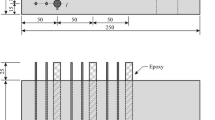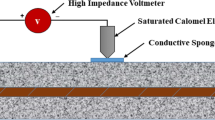Abstract
This paper describes a part of the work in the development of a “standard” test method for determining chloride threshold values required to initiate corrosion on reinforcement in concrete. The prerequisites of the test set-up are that the test conditions should be reasonably comparable to those in service and the test method should be fairly reproducible and as rapid as possible concerning the slow diffusion nature of the investigated phenomenon. This paper presents the results from a study on the influence of steel bar surface condition on chloride induced corrosion. Various electrochemical techniques were employed in the study to monitor the corrosion behaviour of the embedded bars with three different surface conditions. It is shown that the steel surface condition has a strong effect on the corrosion initiation of reinforcement in concrete, and can likely be the most decisive parameter attributing to the variability in the reported chloride threshold values.

















Similar content being viewed by others
References
Alonso C, Castellote M, Andrade C (2002) Chloride threshold dependence of pitting potential of reinforcements. Electrochim Acta 47(21):3469–3481
Alonso MC, Sanchez M (2009) Analysis of the variability of chloride threshold values in the literature. Mater Corros 60(8):631–637. doi:10.1002/maco.200905296
American Association of State Highway and Transportation Officials (1997) AASHTO-T260 Standard method of test for sampling and testing for chloride ion in concrte and concrete raw materials
Andrade C, Alonso C, Gulikers J, Polder R, Cigna R, Vennesland Ø, Salta M, Raharinaivo A, Elsener B (2004) Test methods for on-site corrosion rate measurements of steel reinforcement in concrete by means of the polarization resistance method. Mater Struct 37(9):623–643. doi:10.1007/BF02483292
Angst U, Elsener B, Larsen CK, Vennesland Ø (2009) Critical chloride content in reinforced concrete—a review. Cem Concr Res 39(12):1122–1138. doi:10.1016/j.cemconres.2009.08.006
Angst UM, Elsener B, Larsen CK, Vennesland Ø (2011) Chloride induced reinforcement corrosion: electrochemical monitoring of initiation stage and chloride threshold values. Corros Sci 53(4):1451–1464. doi:10.1016/j.corsci.2011.01.025
Arup H (1983) The mechanisms of protection of steel by concrete. In: Crane AP (ed) Corrosion of reinforcement in concrete structures. Ellis Norwood Ltd, Chichester, pp 151–157
Arup H, Sørensen HE (1995) A proposed technique for determining chloride thresholds. In: Nilsson L-O, Ollivier JP (eds) Chloride penetration in concrete. International RILEM workshop, St-Rémy-lès-Chevreuse, pp 460–469
Benture A, Diamond S, Berke NS (1997) Steel corrosion in concrete—Fundamentals and civil engineering practice. Taylor & Francis, London
Bertolini L, Elsener B, Pedeferri P, Polder R (2004) Corrosion of steel in concrete—prevention, diagnosis, repair. Wiley, Weinheim
Elsener B, Andrade C, Gulikers J, Polder R, Raupach M (2003) Half-cell potential measurements—potential mapping on reinforced concrete structures. Mater Struct 36(7):461–471. doi:10.1007/BF02481526
Ghods P, Isgor OB, McRae GA, Li J, Gu GP (2011) Microscopic investigation of mill scale and its proposed effect on the variability of chloride-induced depassivation of carbon steel rebar. Corros Sci 53(3):946–954. doi:10.1016/j.corsci.2010.11.025
Glass GK, Buenfeld NR (1995) Chloride threshold levels for corrosion induced deterioration of steel in concrete. In: Nilsson L-O, Ollivier JP (eds) Chloride penetratration in concrete. International RILEM workshop, St-Rémy-lès-Chevreuse, pp 429–440
González JA, Miranda JM, Otero E, Feliu S (2007) Effect of electrochemically reactive rust layers on the corrosion of steel in a Ca(OH)2 solution. Corros Sci 49(2):436–448. doi:10.1016/j.corsci.2006.04.014
Hansson CM (1984) Comments on electrochemical measurements of the corrosion of steel in concrete. Cem Concr Res 14(4):574–584. doi:10.1016/0008-8846(84)90135-2
Hansson C, Sørensen B (1988) The threshold concentration of chloride in concrete for the initiation of reinforcement corrosion. In: Berke NS, Chake V, Whiting D (ed), Corrosion rates of steel in concrete, ASTM STP 1065, Baltimore, pp 3–16
Hobbs DW (2001) Concrete deterioration: causes, diagnosis, and minimising risk. Int Mater Rev 46(3):117–144. doi:10.1179/095066001101528420
Li L, Sagüés AA (2001) Chloride corrosion threshold of reinforcing steel in alkaline solutions—open-circuit immersion test. Corrosion 57(1):19–28. doi:10.5006/1.3290325
Mammoliti LT, Brown LC, Hansson CM, Hope BB (1996) The influence of surface finish of reinforcing steel and ph of test solution on the chloride threshold concentration for corrosion initiation in synthetic pore solutions. Cem Concr Res 26(4):545–550. doi:10.1016/0008-8846(96)00018-X
Matsushima I (2000) Localized corrosion of iron and steel. In: Revie RW (ed) Uhlig´s Corrosion Handbook, 3rd edn. Wiley, New York, pp 615–620
McCafferty E (2010) Introduction to corrosion science. Springer, New York
Mohammed TU, Hamada H (2006) Corrosion of steel bars in concrete with various steel surface conditions. ACI Mater J 103(4):233–242
Nilsson L-O (2000) A numerical model for combined diffusion and convection of chloride ion in non-saturated concrete. In: Andrade C, Kropp J (eds) 2nd International RILEM Workshop on Testing and Modelling the Chloride Ingress into Concrete. RILEM Publications, Paris, pp 261–275
Novak P, Mala R, Joska L (2001) Influence of pre-rusting on steel corrosion in concrete. Cem Concr Res 31(4):589–593. doi:10.1016/S0008-8846(01)00459-8
Nygaard PV (2003) Effect of steel-concrete interface defects on the chloride threshold for reinforcement corrosion. Master Thesis, Technical University of Denmark
Nygaard PV, Geiker MR (2006) A method for measuring the chloride threshold value level required to initiate reinforcement corrosion in concrete. Mater Struct 38(4):489–494. doi:10.1007/BF02482145
Page CL (2009) Initiation of chloride-induced corrosion of steel in concrete: role of the interfacial zone. Mater Corros 60(8):586–592. doi:10.1002/maco.200905278
Page CL, Treadaway KWJ (1982) Aspects of the electrochemistry of steel in concrete. Nature 297:109–115. doi:10.1038/297109a0
Rossi A, Puddu G, Elsener B (2007) The surface of iron and Fe10Cr alloys in alkaline media. In: Raupach M, Elsener B, Polder R, Mietz J (ed) Corrosion of reinforcement in concrete. EFC Publication No. 38, Woodhead Publishing, Cambridge, pp 44–61
Sandberg P (1998) Chloride initiated reinforcement corrosion in marine concrete. Dissertation, Lund University
Silva N (2013) Chloride induced corrosion of reinforcement steel in concrete—threshold values and ion distributions at the concrete-steel interface. Dissertation, Chalmers University of Technology
Shibata T (2000) Corrosion probability and statistical evaluation of corrosion data. In: Revie RW (ed) Uhlig´s corrosion handbook, 3rd edn. Wiley, New York, pp 365–386
Tang L (2002) Mapping corrosion of steel in reinforced concrete structures. SP Report 2002:32, SP Swedish National Testing and Research Institute, Borås
Tang L (2003) Estimation of cement/binder profile parallel to the determination of chloride profile in concrete. SP Report 2003:07, SP Swedish National Testing and Research Institute, Borås
Tang L, Fu Y (2006) A rapid technique using a hand held instrument for mapping corrosion of steel in reinforced concrete. Restor Build Monum 12(5/6):387–400
Tang L, Utgenannt P (2009) A field study of critical chloride content in reinforced concrete with blended binder. Mater Corros 60(8):617–622. doi:10.1002/maco.200905282
Treadaway KWJ, Cox RN, Brown BL (1989) Durability of corrosion resisting steels in concrete. ICE Proc 86(2):305–331. doi:10.1680/iicep.1989.1628
Tuutti K (1982) Corrosion of steel in concrete. Dissertation, Swedish Cement and Concrete Research Institute
Yonezawa T, Ashworth V, Procter RPM (1988) Pore solution composition and chloride effect on the corrosion of steel in concrete. Corrosion 44(7):489–499. doi:10.5006/1.3583967
Acknowledgments
The authors are grateful for the financial support from the Swedish Consortium for Financing Basic Research in the Field of Concrete.
Author information
Authors and Affiliations
Corresponding author
Rights and permissions
About this article
Cite this article
Boubitsas, D., Tang, L. The influence of reinforcement steel surface condition on initiation of chloride induced corrosion. Mater Struct 48, 2641–2658 (2015). https://doi.org/10.1617/s11527-014-0343-2
Received:
Accepted:
Published:
Issue Date:
DOI: https://doi.org/10.1617/s11527-014-0343-2




